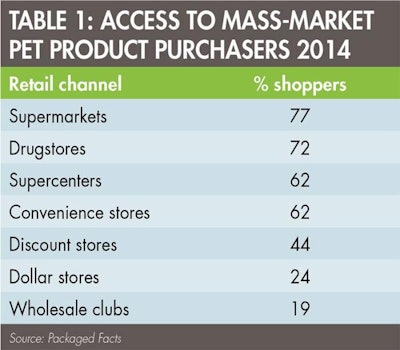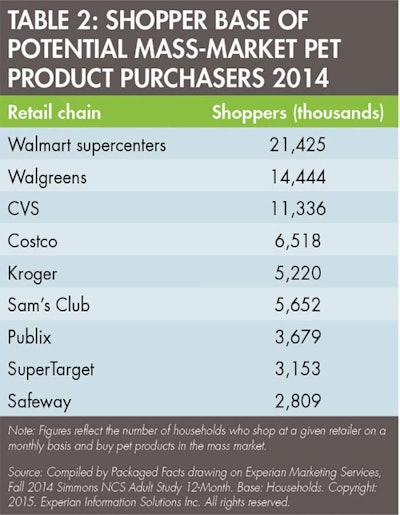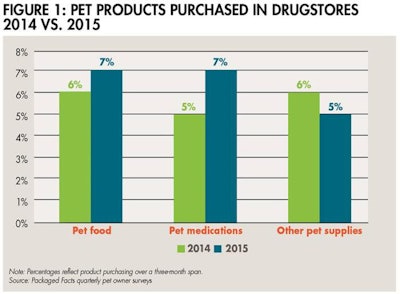On a monthly basis, which two retail channels draw the largest traffic of shoppers who purchase pet products in the mass market? You might only get one answer right, unless you know that drugstores (which see 72% of shoppers who buy pet products in mass-market channels stream through their doors) rank second only to supermarkets (at 77%) by this measure (see Table 1).

Drugstores are the second-most popular retail channel for shoppers who purchase their pet products via mass market, beating out supercenters and coming in only slightly behind supermarkets.
From this potential-based perspective of access to mass-market pet product shoppers, moreover, drugstores account for two out of the top three retail chains. Walmart supercenters, not surprisingly, lead the pack: 21.4 million households who shop at Walmart supercenters buy pet products in the mass market, and thus are current or at least potential pet department customers.
Walgreens and CVS follow in the list. That is, 14.4 million households who shop at Walgreens buy mass-market pet products, as do 11.3 million who shop at CVS. For perspective, Walgreens draws more potential customers for mass-market pet products than do Costco and Sam’s Club and BJ’s in combination, and both Walgreens and CVS draw more than Kroger and Safeway and Publix combined (see Table 2).

Unsurprisingly, 21.4 million customers who shop at Walmart supercenters buy pet products in the mass market—beating out second-place Walgreens by 7 million shoppers—and so are current or at least potential pet department customers.
Several factors account for this perhaps surprising hierarchy of pet department potential. One overarching factor is the high degree of chain consolidation in the drugstore channel compared with the supermarket arena (though the discount store/supercenter, warehouse club and dollar store channels are similarly dominated by a handful of players). In addition, drugstore chain consolidation has increased over the last decade. In 2004, 28% of dog or cat owners shopped at Walgreens and 20% shopped at CVS. By 2015, those figures had notched up to 37% and 30%, respectively.
In a reverse trend, the range of retail pharmacies angling for the pet medications market has been expanding. The veterinary channel, though still accounting for half of pet medication sales, is gradually losing ground to brick-and-mortar and online retailers, most visibly in the case of flea/tick prescription medications for dogs. Drugstore chains, being well-positioned to tap into expanding pet medication distribution—the same medications are commonly prescribed for pet parents and pets—have been happy to hitch a companion animal sidecar to their core human pharmacy competency. And many pet owners are willing to make this switch, motivated by the reality or perception that they pay more for pet meds at the vet.
Drugstores have taken significant steps to reach out proactively to the potential pet product customers streaming through their aisles, as exemplified by Walgreens’ private label Pet Shoppe line, and such efforts have begun to pay off. Between 2010 and 2014, albeit off a relatively small dollar sales base, dog food sales at drugstores jumped by 26% to US$150 million. Moreover, Packaged Facts survey data cited in our new Pet Medications in the US (July 2015) report show the percentage of pet product shoppers buying pet food at drugstores improving from 6% in 2014 to 7% in 2015, as the percentage buying pet medications in this channel edged up from 5% to 7% (see Figure 1).

The percentage of pet product buyers purchasing pet food and pet medications in drugstores has increased from 2014 to 2015.
Even so, considering that drugstores rank second by access to mass-market pet product shoppers but garner only 2% of mass-market pet product sales, that’s just the actualized peak of a mountain’s worth of potential. Many drugstores field only small pet needs departments geared to fill-in or impulse purchases, with roughly equal space for pet food and non-food supplies, and without creative leveraging of the central health and wellness proposition unique to the drugstore channel. Given that pet product shoppers are not particularly channel loyal, and the robust interest in pet health and wellness that’s driving sales of premium and superpremium pet nutrition products, this could be a sleeping Saint Bernard of an opportunity.
A pharmacy dispensing flea and tick meds could be a great platform for a skin-and-coat dog food formulation with omega fatty acids to help with itching and scratching. And why not feature pet supplements in the main vitamins department (synergizing with parallel people/pet prescriptions) or pet dental treats in the main oral care aisle, thereby making the case in these destination departments for drugstores as progressive pet needs retailers? And because dogs and cats are very much part of the family, pet needs can be featured in wellness programs and shopper loyalty rewards—giving notice that drugstores mean business with pet health, too.















